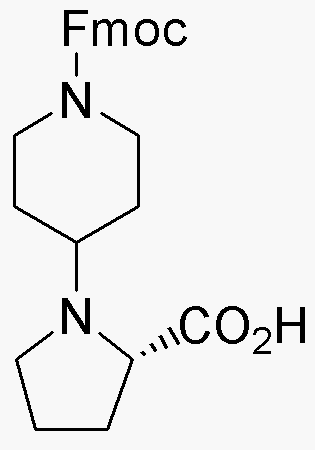Fmoc-4-piperidino-L-proline is widely utilized in research focused on:
- Peptide Synthesis: This compound serves as a key building block in solid-phase peptide synthesis, allowing researchers to create complex peptides with specific functionalities for various applications.
- Drug Development: It is used in the design of peptide-based drugs, particularly in the development of therapeutics targeting specific biological pathways, enhancing drug efficacy and specificity.
- Bioconjugation: The compound facilitates bioconjugation processes, enabling the attachment of peptides to other biomolecules, which is crucial in creating targeted drug delivery systems.
- Research in Neuroscience: Its structural properties make it valuable in studying neuropeptides, contributing to the understanding of neurological disorders and potential treatments.
- Custom Synthesis: Researchers appreciate its versatility in custom synthesis projects, allowing for the modification of peptide sequences to tailor them for specific research needs.
General Information
Properties
Safety and Regulations
Applications
Fmoc-4-piperidino-L-proline is widely utilized in research focused on:
- Peptide Synthesis: This compound serves as a key building block in solid-phase peptide synthesis, allowing researchers to create complex peptides with specific functionalities for various applications.
- Drug Development: It is used in the design of peptide-based drugs, particularly in the development of therapeutics targeting specific biological pathways, enhancing drug efficacy and specificity.
- Bioconjugation: The compound facilitates bioconjugation processes, enabling the attachment of peptides to other biomolecules, which is crucial in creating targeted drug delivery systems.
- Research in Neuroscience: Its structural properties make it valuable in studying neuropeptides, contributing to the understanding of neurological disorders and potential treatments.
- Custom Synthesis: Researchers appreciate its versatility in custom synthesis projects, allowing for the modification of peptide sequences to tailor them for specific research needs.
Documents
Safety Data Sheets (SDS)
The SDS provides comprehensive safety information on handling, storage, and disposal of the product.
Product Specification (PS)
The PS provides a comprehensive breakdown of the product’s properties, including chemical composition, physical state, purity, and storage requirements. It also details acceptable quality ranges and the product's intended applications.
Certificates of Analysis (COA)
Search for Certificates of Analysis (COA) by entering the products Lot Number. Lot and Batch Numbers can be found on a product’s label following the words ‘Lot’ or ‘Batch’.
Numéro de catalogue
Numéro de lot/série
Certificates Of Origin (COO)
This COO confirms the country where the product was manufactured, and also details the materials and components used in it and whether it is derived from natural, synthetic, or other specific sources. This certificate may be required for customs, trade, and regulatory compliance.
Numéro de catalogue
Numéro de lot/série
Safety Data Sheets (SDS)
The SDS provides comprehensive safety information on handling, storage, and disposal of the product.
DownloadProduct Specification (PS)
The PS provides a comprehensive breakdown of the product’s properties, including chemical composition, physical state, purity, and storage requirements. It also details acceptable quality ranges and the product's intended applications.
DownloadCertificates of Analysis (COA)
Search for Certificates of Analysis (COA) by entering the products Lot Number. Lot and Batch Numbers can be found on a product’s label following the words ‘Lot’ or ‘Batch’.
Numéro de catalogue
Numéro de lot/série
Certificates Of Origin (COO)
This COO confirms the country where the product was manufactured, and also details the materials and components used in it and whether it is derived from natural, synthetic, or other specific sources. This certificate may be required for customs, trade, and regulatory compliance.


